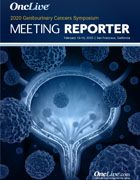Publication
Article
Supplements and Featured Publications
Apalutamide Delivers PFS2 Benefit in mCSPC, Regardless of Subsequent Therapy
Author(s):
Adding apalutamide to androgen deprivation therapy reduced the risk of second progression or death by 34% compared with ADT alone in patients with metastatic castration-sensitive prostate cancer.
Neeraj Agarwal, MD, associate professor of medicine, University of Utah School of Medicine; and director, Genitourinary Oncology Program, Oncology Division, co-leader, Urologic Oncology Multidisciplinary Program, associate director of Clinical Trials, Huntsman Cancer Institute

Neeraj Agarwal, MD
Adding apalutamide (Erleada) to androgen deprivation therapy (ADT) reduced the risk of second progression or death (PFS2) by 34% compared with ADT alone in patients with metastatic castration-sensitive prostate cancer (CSPC). The PFS2 benefit occurred regardless of the first subsequent systemic therapy following study treatment, according to a posthoc analysis of the phase III TITAN trial presented at the 2020 Genitourinary Cancers Symposium.1
The hazard ratio for PFS2 favoring the apalutamide arm was 0.66 (95% CI, 0.50-0.87; P = .0026). The significant advantage to apalutamide was consistent regardless of whether patients received hormonal therapy (HR, 0.684; 95% CI, 0.482-0.971; P = .0326) or a taxane (HR, 0.634; 95% CI, 0.456-0.881; P = .0062) as first subsequent treatment. The median PFS2 was not reached for either apalutamide or placebo in each of the subsequent treatment arms.
PFS2 benefit is an indicator of effective early intensification of treatment, is consistent with the overall survival (OS) benefit generated by apalutamide, “and together shows the totality of treatment trajectory,” said lead study author Neeraj Agarwal, MD, Huntsman Cancer Center, University of Utah, Salt Lake City.
The main results from TITAN, published in the New England Journal of Medicine,2 demonstrated a reduction in the risk of death by 33% with the addition of apalutamide to ADT. At a median follow-up of 22.7 months, the 2-year OS rate was 82.4% in the apalutamide arm compared with 73.5% in patients receiving ADT alone (HR, 0.67; 95% CI, 0.51-0.89; P = .005). The median OS was not yet reached in either arm. Addition of apalutamide also significantly reduced the risk of radiographic progression or death by 52%.
Based on these primary data, the FDA approved apalutamide in September 2019 for the treatment of patients with metastatic CSPC. The initial approval of apalutamide, in 2018, was for the treatment of patients with nonmetastatic castration-resistant prostate cancer.
The international, double-blind TITAN study enrolled an all-comer population of 1052 patients with metastatic CSPC, regardless of prior docetaxel treatment or disease extent. Patients were randomized to oral apalutamide at 240 mg once daily plus ADT or placebo combined with ADT until disease progression, unacceptable toxicity, or end of treatment.
For this analysis, PFS2 was defined as the time from randomization to first occurrence of investigator-determined disease progression while the patient was receiving first subsequent therapy for prostate cancer, or death due to any cause, whichever occurred first. The analysis censored for all other first subsequent systemic therapies.
A total of 277 patients received subsequent systemic therapy for prostate cancer, 87 patients in the apalutamide plus ADT arm and 190 in the placebo plus ADT arm. Novel hormonal therapy was received as first subsequent therapy by 24 patients in the apalutamide arm and by 62 in the control arm. Taxane therapy was the first subsequent therapy in 30 patients in the apalutamide arm and 69 in the control arm.
Baseline demographics and disease characteristics were similar between the hormonal and taxane groups, including ECOG performance score, Gleason score at initial diagnosis, metastasis stage at diagnosis, and median prostate-specific antigen level at baseline. Patients who received prior docetaxel in the castration-sensitive setting before enrollment in TITAN were more likely to have received a novel hormonal therapy versus taxane therapy as a first subsequent therapy (20.9% vs. 8.1%).
Agarwal noted as a limitation that selection of subsequent therapy was not randomized, instead chosen by the primary physician based on patient and disease characteristics. “The small number of events on subsequent therapy and the nonrandomized treatment decision preclude determination of best subsequent therapy based on these data,” he said. “Further maturation of data is needed for additional in-depth analysis.”
Discussant Dana Rathkopf, MD, director of clinical research, prostate cancer, Memorial Sloan Kettering Cancer Center, also pointed to the small number of PFS2 events in both the hormonal arm (19.5%) and the taxane arm (22.4%) in the analysis “and as a result, these need to be interpreted with some caution.”
Due to the small number of events, “further follow-up is needed to assess the full impact of subsequent therapy on time to PFS2,” she said.
The duration of first therapy after apalutamide or placebo was 11.0 to 11.9 months in each of the arms, she pointed out. The requirement to progress twice meant that the study selected for poor responders who were on treatment for <12 months, she said. “If the patients were all on their treatment for about 12 months, it does make you wonder why apalutamide patients responded better than placebo to a second hormone therapy, because you might think that in the setting of poor response to upfront apalutamide, these patients may develop some type of intrinsic resistance that would suggest that they would not respond as well to a second line androgen receptor inhibitor relative to a taxane,” said Rathkopf.
Finally, the imbalance of prior docetaxel therapy between the apalutamide and placebo arms in those who received subsequent hormonal therapy (33% vs 16%) also may have influenced outcomes, she said.
References
- Agarwal N, Chowdhury S, Bjartell A, et al. Time to second progression (PFS2) in patients (pts) from TITAN with metastatic castration-sensitive prostate cancer (mCSPC) by first subsequent therapy (hormonal vs. taxane). Presented at: Genitourinary Cancers Symposium; February 13-15, 2020; San Francisco, CA. Abstract 82
- Chi KN, Agarwal N, Bjartell A, et al. Apalutamide for metastatic, castration-sensitive prostate cancer [published online May 31, 2019]. N Engl J Med. doi: 10.1056/NEJMoa1903307.










